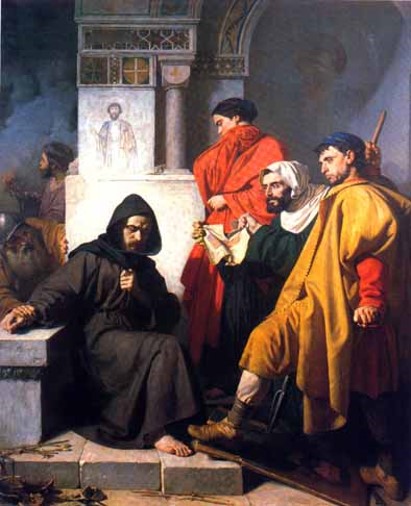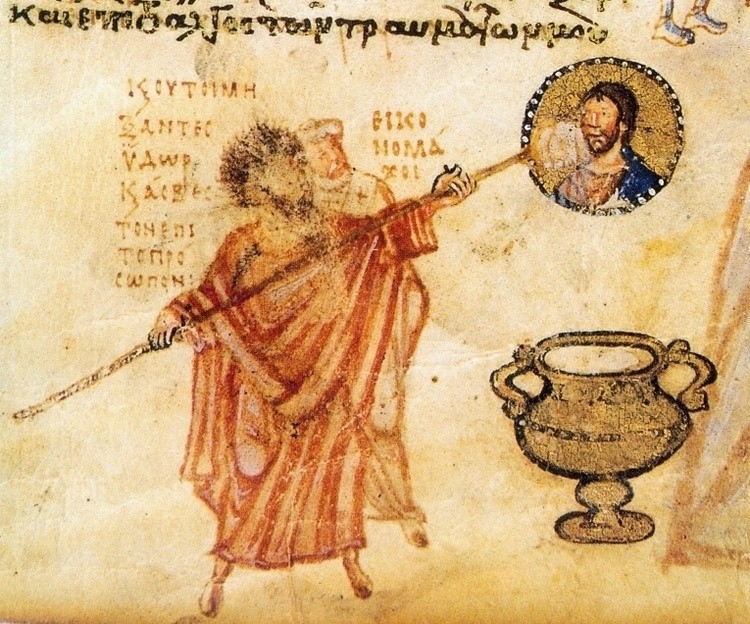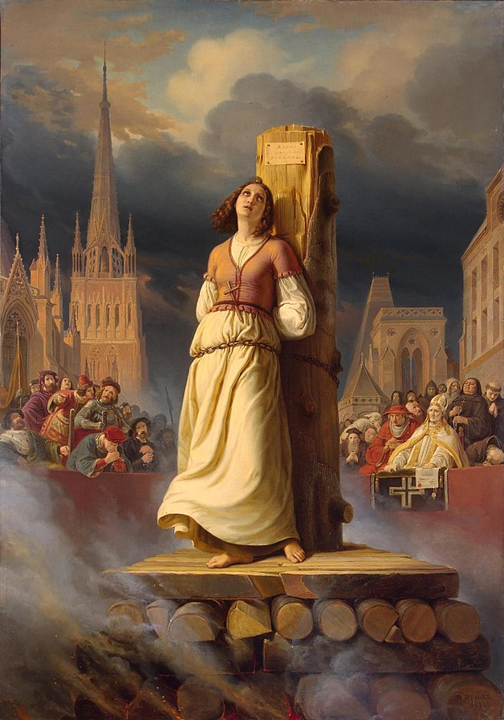The words covered in this article are iconoclasm and iconoclast, heresy and heretic, extirpate and extirpation, persecution, and prototype. Previously done words that will reoccur today are propitiate, decree, edict, promulgate, venerate, obscure, tangible, analogy proscription, vivid, unequivocal, and contentious.
You learnt yesterday how the Byzantine emperor Leo III had interpreted a volcanic eruption as a sign of God’s displeasure at the rampant icon-worship in his kingdom; so, to propitiate God’s anger, he decreed that all images of Christ and the saints in the Byzantine empire should be smashed.
With the announcement of this edict/decree, emperor Leo put into operation a law to smash holy icons. He promulgated a policy of . . . iconoclasm.
Iconoclasm
Iconoclasm means the deliberate breaking or destruction within a culture of that culture’s own religious icons. Remember that by ‘icons’, we mean those images or symbols that are venerated as sacred.
The people who destroy icons, as well as the people who support such destruction, are known as iconoclasts.
Mnemonic: The clast part of this word rhymes with blast; a blast shatters a thing into thousand pieces – so, you can remember iconoclasts as ‘icon blasters, the men who shatter an icon into a thousand pieces.’
The men in this painting are iconoclasts, because they are Christians who are destroying a painting of their own religious father: Jesus Christ.

If the icon in question is a statue, iconoclasts may destroy it by smashing it into pieces. If it is a painting, they may stomp over it, as depicted by Morelli above, or obscure it in one of the following ways:
Here is a picture of an iconoclastic senior Christian leader of Constantinople, trying to rub off a painting of Christ with sponge.

The iconoclastic edict of emperor Leo also declared that any citizen found venerating an icon even privately in his own home would be treated as a heretic.
Heresy
The word heresy is usually used in religious contexts, for any belief that goes against what one’s religion says on the topic. Any such belief is deemed heretical.
For example, in 1593, Italian astronomer Giordano Bruno was accused of heresy by the Roman Catholic Church, because he held beliefs that went against the Church’s teachings. He said that the universe was infinite and had no center, whereas the Church held that the center of the universe was earth.
A person who holds a heresy is called a heretic. History tells us about many heretics who were burned at the stake for their heresies. A ‘stake’ is a wooden post to which a person is tied before being killed. Astronomer Bruno too was burned at the stake.

In the Byzantine empire, after emperor Leo III and the priests who supported him had publicly declared that icons should not be venerated, if you were a citizen who still paid your respects to an icon, then you were demonstrating a belief that went against the emperor and the Church. So, you were a heretic!
But of course, to declare a belief to be heresy is one thing; to actually be able to extirpate that belief is quite another.
Extirpate
Extirpate means to destroy completely, to pull out by the roots.
Usage examples:
- No society is devoid of religion, even those that have made deliberate attempts to extirpate it.
- Many people believe that to extirpate crime, a society needs to create not the fear of the consequences of doing evil but the desire in everybody to do good.
When emperor Leo undertook to extirpate icon veneration, he set in motion a series of events that were to have profound effects on the course of history. To his people, icons were an inseparable part of their religion. People’s minds, especially in religious matters, cannot be changed overnight by issuing a decree and threatening to punish those who don’t obey. The immediate aftermath of the emperor’s iconoclastic edict was a public riot.
There hung a 400-year-old bronze statue of Jesus Christ over one of the gates of the royal palace. It was believed to symbolize Christ’s protection of the empire. When emperor Leo proscribed icon veneration, his first order was that this icon be removed and destroyed.
This infuriated the citizens, who gathered outside the palace to prevent the order from being carried out. A soldier had climbed up a ladder to reach the statue when a nun named Theodosia shook the ladder until the soldier fell from it; he died from the injuries and the nun was arrested. For a week, she was given a hundred lashes each day. On the eighth day, royal soldiers made her walk the city streets, beating her cruelly every few minutes, and at the end of the round, executed her.
The emperor may have hoped that Theodosia’s example would frighten people into quietly accepting the iconoclastic policy, but her public humiliation had, in fact, the opposite effect. She was hailed as a martyr to a righteous cause and her body was reverently buried by devout Christians in a monastery. Later, she was designated a Saint.
What the emperor saw as deserved punishment for breaking a royal order, the common people saw as persecution.
Persecution
To persecute someone is to torture or ill-treat them because of their religion, race, gender, or beliefs. Such torture or ill-treatment is called persecution.
(Do not confuse persecute with ‘prosecute’,which means to start or conduct a legal case against someone. Let’s say that in a murder case, the police claims John to be the murderer. In the court, two lawyers will fight this case – one will represent John and the other will represent the police/the state/ the society. John’s lawyer is called a ‘defense lawyer;’ his job is to defend John against the police’s accusations. The other lawyer is called a ‘public prosecutor;’ his job is to argue the police’s case against John.)
‘Discrimination’is a word that we are well-familiar with, and discriminatory behavior against a person or a group too usually stems from their religion, race, gender, or beliefs. Is ‘discrimination’ synonymous with ‘persecution’ then? No. Persecution is one type of discrimination: the cruelest type. We use the word persecution when the harm done to the discriminated people is so serious that their very survival is threatened. The dynamic between socially powerful group(s) and persecuted people is the same as that between predators and prey. To use the notation that we discussed in Day 10 for analogies:
Persecutor : Persecuted : : Predator : Prey
Making icon veneration illegal was the easy part. The trouble lay in the enforcement of this law. People refused to accept it by their own free will, and when the emperor tried to make them obey – by smashing icons and punishing icon venerators – they called him their persecutor, clashed with his soldiers, and hailed the killed protestors as martyrs.
You might wonder, where were the supposed experts of all religious matters – the clergy (the priests and church leaders) – amid this chaos? Why did they not use their knowledge of the Bible to guide the emperor and the people towards the right choice between image veneration and iconoclasm? Well, they could not because they were themselves having a hot and bitter debate about this issue.
One camp of church leaders sincerely believed that icon veneration was okay. For them, icons were like windows through which ordinary people could get a glimpse of God and feel in contact with Him. As one clergyman argued:
“If I point to a statue of Caesar and ask you ‘Who is that?’, your answer would properly be, ‘It is Caesar.’ When you say this, you do not mean that the stone itself is Caesar but, rather, that the statue is a representation of its prototype, which is Caesar. So, it is with an icon.”
Prototype
Prototype means the original that serves as the model for later reproductions.
As per this first group of clergymen, an icon is only a likeness, a tangible object that stands for its prototype. When a person kisses an icon of Jesus Christ, he is not showing love to a stone figurine but to his dear Jesus. He is not worshipping the idol but is worshipping via the idol, and that is okay, because ‘God’ is an abstract concept that is difficult for common people to fully understand. What would be wrong is if a person started believing that stone figurine itself to be an all-powerful god; that would be a violation of the Biblical proscription of idolatry. But as long as people do not make this error, icon veneration is perfectly all right.
Recall your science books from school and college; what would have been the impact on your learning if those books had no diagrams or model-making ideas? Just as diagrams and models aid our study of science by making the abstract scientific phenomena more vivid, so was the role that the first group of clergymen thought icons played in religion.
On the other side was the group of clergymen who pointed to the unequivocal language of the first commandment (earlier discussed in Day 9) as proof that Christians were not allowed even to make icons, leave alone being allowed to worship them. Recall the first commandment:
“You must not have any other god but me.
You must not make for yourself an idol of any kind or an image of anything in the heavens or on the earth or in the sea. You must not bow down to them or worship them, for I, the Lord your God, am a jealous God who will not tolerate your affection for any other gods.”
Exodus 20, New Living Translation
As per this group, icon veneration meant the same as idolatry and was a sin; they welcomed iconoclasm as a much-needed religious reform.
Thus, the Christian scholars, experts and leaders were themselves engaged in a contentious debate about iconoclasm and could not provide clear guidance to the emperor and the populace.
In the years after the promulgation of iconoclasm, emperor Leo achieved many military successes, which convinced him that he had succeeded in propitiating God and strengthened his resolve to continue the iconoclastic policy even in the face of stiff public resistance.
Years rolled by, Leo died, and the throne passed to his son, Constantine V, who was much more ruthless in enforcing the iconoclastic policy – he burned monasteries that still practiced icon veneration, ensured the destruction of all religious images that he could find, and turned icon-loving churches into stables.
The iconoclastic period lasted about 125 years. It finally ended in 843 AD when a Church council under a new emperor ruled that icon veneration was NOT idolatry, but rather, was an integral part of Christian worship rituals.
However noble emperor Leo’s intentions may have been, today he is known primarily for his relentless persecution of icon venerators, which led to widespread destruction of Christian art and icons made in the first eight centuries after the birth of Jesus Christ. History is written by victors and the icon venerators were the ones who eventually won this face-off.
See you in Day 14.